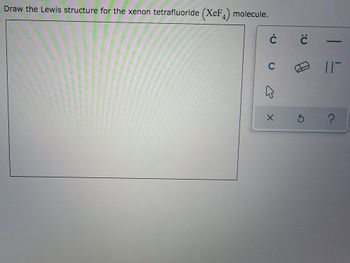
Chemistry
10th Edition
ISBN: 9781305957404
Author: Steven S. Zumdahl, Susan A. Zumdahl, Donald J. DeCoste
Publisher: Cengage Learning
expand_more
expand_more
format_list_bulleted
Question

Transcribed Image Text:**Drawing the Lewis Structure for Xenon Tetrafluoride (XeF₄)**
Welcome to our interactive learning session on the Lewis structures of molecules! Today, we will focus on drawing the Lewis structure for xenon tetrafluoride (XeF₄).
### Step-by-Step Guide
1. **Identify the Total Number of Valence Electrons:**
- Xenon (Xe) has 8 valence electrons.
- Each fluorine (F) atom has 7 valence electrons.
- Total number of valence electrons in XeF₄:
\( 1 \, \text{Xe} \times 8 \, \text{electrons} + 4 \, \text{F} \times 7 \, \text{electrons} = 8 + 28 = 36 \, \text{electrons} \).
2. **Draw the Skeleton Structure:**
- Place the least electronegative atom (Xe) in the center.
- Attach the four fluorine atoms to the xenon atom using single bonds.
3. **Distribute the Remaining Electrons:**
- Each single bond (X-F) requires 2 electrons, thus, 4 bonds use \( 4 \times 2 = 8 \) electrons.
- Subtract the bonded electrons from the total valence electrons: \( 36 - 8 = 28 \) electrons remaining.
- Distribute these remaining 28 electrons around the fluorine atoms, ensuring each fluorine receives 8 electrons to complete its octet (bonding pair + lone pairs).
4. **Distribute Lone Pairs to Central Atom:**
- After satisfying the octets of the fluorine atoms, any remaining electrons are placed on the central xenon atom.
- Xenon can accommodate more than 8 electrons (expanded octet) because it is in Period 5 of the periodic table.
### Diagram Tools
- There is an interactive canvas on the right with tools for drawing:
- **Bond Tool (single bond):** Used to draw bonds between atoms.
- **Lone Pair Electron Tool:** Used for adding lone pairs to atoms.
- **Erase Tool:** For correcting mistakes.
- **Undo Button:** To revert the last action.
- **Help Button (? symbol):** Access help documentation.
These tools will aid in accurately representing the Lewis structure of XeF
Expert Solution
This question has been solved!
Explore an expertly crafted, step-by-step solution for a thorough understanding of key concepts.
Step by stepSolved in 2 steps with 2 images

Knowledge Booster
Learn more about
Need a deep-dive on the concept behind this application? Look no further. Learn more about this topic, chemistry and related others by exploring similar questions and additional content below.Similar questions
- The physical and chemical properties of a molecule depend on its structure. Here are two ball-and-stick models for two compounds that have the same molecular formula but different structures and different chemical properties. Ethanol Dimethyl etherarrow_forwardDraw the Lewis structure of FeCl3.6H2O and FeCl2.4H2O.arrow_forwardWhy SiH4 has lowest freezing point than CH4?arrow_forward
arrow_back_ios
SEE MORE QUESTIONS
arrow_forward_ios
Recommended textbooks for you
 ChemistryChemistryISBN:9781305957404Author:Steven S. Zumdahl, Susan A. Zumdahl, Donald J. DeCostePublisher:Cengage Learning
ChemistryChemistryISBN:9781305957404Author:Steven S. Zumdahl, Susan A. Zumdahl, Donald J. DeCostePublisher:Cengage Learning ChemistryChemistryISBN:9781259911156Author:Raymond Chang Dr., Jason Overby ProfessorPublisher:McGraw-Hill Education
ChemistryChemistryISBN:9781259911156Author:Raymond Chang Dr., Jason Overby ProfessorPublisher:McGraw-Hill Education Principles of Instrumental AnalysisChemistryISBN:9781305577213Author:Douglas A. Skoog, F. James Holler, Stanley R. CrouchPublisher:Cengage Learning
Principles of Instrumental AnalysisChemistryISBN:9781305577213Author:Douglas A. Skoog, F. James Holler, Stanley R. CrouchPublisher:Cengage Learning Organic ChemistryChemistryISBN:9780078021558Author:Janice Gorzynski Smith Dr.Publisher:McGraw-Hill Education
Organic ChemistryChemistryISBN:9780078021558Author:Janice Gorzynski Smith Dr.Publisher:McGraw-Hill Education Chemistry: Principles and ReactionsChemistryISBN:9781305079373Author:William L. Masterton, Cecile N. HurleyPublisher:Cengage Learning
Chemistry: Principles and ReactionsChemistryISBN:9781305079373Author:William L. Masterton, Cecile N. HurleyPublisher:Cengage Learning Elementary Principles of Chemical Processes, Bind...ChemistryISBN:9781118431221Author:Richard M. Felder, Ronald W. Rousseau, Lisa G. BullardPublisher:WILEY
Elementary Principles of Chemical Processes, Bind...ChemistryISBN:9781118431221Author:Richard M. Felder, Ronald W. Rousseau, Lisa G. BullardPublisher:WILEY

Chemistry
Chemistry
ISBN:9781305957404
Author:Steven S. Zumdahl, Susan A. Zumdahl, Donald J. DeCoste
Publisher:Cengage Learning

Chemistry
Chemistry
ISBN:9781259911156
Author:Raymond Chang Dr., Jason Overby Professor
Publisher:McGraw-Hill Education

Principles of Instrumental Analysis
Chemistry
ISBN:9781305577213
Author:Douglas A. Skoog, F. James Holler, Stanley R. Crouch
Publisher:Cengage Learning

Organic Chemistry
Chemistry
ISBN:9780078021558
Author:Janice Gorzynski Smith Dr.
Publisher:McGraw-Hill Education

Chemistry: Principles and Reactions
Chemistry
ISBN:9781305079373
Author:William L. Masterton, Cecile N. Hurley
Publisher:Cengage Learning

Elementary Principles of Chemical Processes, Bind...
Chemistry
ISBN:9781118431221
Author:Richard M. Felder, Ronald W. Rousseau, Lisa G. Bullard
Publisher:WILEY